|
Log
#41—The San Blas Archipelago … Continued
Wednesday March 21 through Wednesday, April
11th, 2001
Thursday
March 22nd we sailed to Green Island (Kanildup) to wait for fuel, delinquent
in arrival because of mechanical problems with the delivery boat. There,
we mostly rested, swam, snorkeled; caught up on e-mail and finances; and
worked on our web site logs. It's amazing how much electricity is required
to create these web site logs while we're cruising: two computers, digital
camera, occasional scanner. Gone are the days of oil lamps and paper charts—at
least for us. This high tech boat needs power. Thankfully we had the engine
running again to supply ample amp charges for our batteries. We loved
every noisy minute of engine time, not to mention those wonderful water
maker pumps that thumped along under the galley sink.
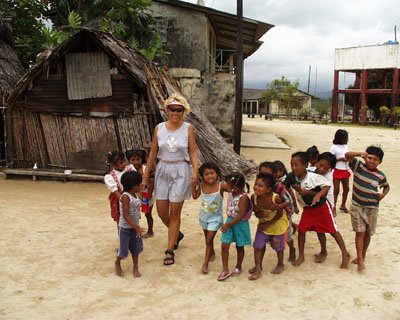 |
|
|
Becky's
Entourage, Rio Azucar Village
|
|
On Friday
the 23rd we made a trip in a dugout canoe to Rio Azucar, one of the nearby
island villages. This island should have been named island of the children,
because of 300 residents, 150 of them were Kuna children under the
age of 10.
A quick tour
of the village attracted virtually every kid in sight, and every single
one of them wanted to hold our hands. All
hopes of taking some candid photos were dashed when the kids discovered
that we had arrived. We—or I should say the digital camera—immediately
became the center of attention.
Every island
village has a school where the kids learn Spanish, in addition to their
native Kuna language. Some schools even teach English, and a few of the
kids tested their skills with a few carefully chosen words, such as "hey!"
Outside of
school, there's not much for the Kuna children to do. There's certainly
no place to go, other than another village, which is pretty similar to
their own. Some of the larger villages, such as Nargana, have DTV satellites,
and we occasionally found kids clustered around a TV watching cartoons.
Monday the
26th we returned to Nargana (Rio Diablo) where Federico had a barrel of
diesel waiting for us. Our (diesel) ship had finally come in. We made
sure that the diesel we purchased came from Panama and not Colombia. The
Colombian diesel often contains water, which is about the worst thing
you can possibly put into diesel engine. Prior to making this transaction,
I asked our contact Federico, on three distinct occasions, about the quality
of this diesel:
| |
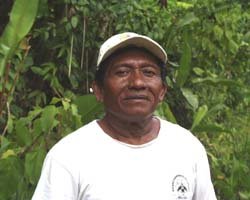 |
|
|
Federico
Morales
Cruiser Support Services Isla Nargana
|
Karl: "¿Esta
diesel es limpio?" ("This diesel is clean?")
Federico:
"Si." (Yes.)
Karl: "¿No
hay aqua en esta diesel?" ("There is no water in this diesel?")
Federico:
"¡NO!" ("No," he said, emphatically.)
Karl: "Bueno,
porque es muy importante. ¿Comprendo?" ("Good, because
this is very important. Understand?")
Federico:
"Si." ("Yes.")
I watched
Federico arrive with another man in a long boat powered by an outboard
motor. They slowly hand pumped the diesel into the tank.
With the
long-awaited diesel fuel in the tank, we decided to return to Green Island
for a few days of repair work and route planning. We motored out of the
small bay when, after about four minutes, the engine died. As the engine
sputtered out, full of water, a small old man approached in his dugout
canoe and motioned us to turn port. Now I know why: we drifted onto the
edge of a shallow mud bar in the bay and grounded. So there we were: firmly
stuck in the mud, and no engine to maneuver with. My stomach dropped out
through the bottom of my feet.
The old man
tried to pry Andanté out of the mud with a long stick—all
15 tons of her. (She's a big girl.) Becky yelled in Spanish, "We
need more strength. The strength of 20-men!" He smiled, turned, and
paddled off toward the village.
I jumped
into the dinghy while Becky lowered our main anchor and 150-feet of chain
into its bow. I motored out, away from the mud bar, and dropped the anchor
overboard. I had the idea of first getting the engine running and then
towing Andanté out of the muck by pulling in the anchor.
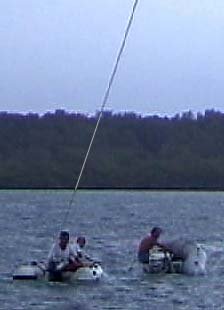 |
|
|
Attempting
to Pull Andanté
Off the Mud Bar
|
|
Meanwhile,
another hopeful solution emerged. Gregoire de Brichambaut, a cruiser from
Paris, motored over in his dinghy with a spare 150-foot line, which we
attached to a halyard on our main mast. His idea was to pull the boat
sideways from the top of the mast, and allow the keel to slip out of the
mud. "Really?" I asked incredulously. "I've done it four
times already," he smiled.
We attached
his line to a spare halyard, and he sped off to salvage us. It turned
out that the size of his dinghy engine wasn't sufficient to dislodge us.
So I motored out with our 10-horse power engine on my dinghy, and the
two of us blasted outboards full power together. This didn't work either.
Gregoire
suggested putting out the mainsail, which was perpendicular to the wind.
Out came the mainsail. Gregoire pulled with his dinghy. Still nothing
happened.
Gregoire
suggested putting out the genoa. Out came the genoa. He pulled hard with
his dinghy and, again, nothing happened. We were clearly, a stick-in-the-mud.
Then, we
spotted three canoes rowing toward us from the island, with eight able-bodied
men. I wasn't sure what their plan was, and thought that they probably
came to watch the festivities. When they arrived, however, all of them
jumped into the water and lined up along the keel. Their idea was to push
us off the mud bank. Reinforcements, perhaps, enlisted by the old man
in the canoe?
Gregoire
drove my dinghy, attached to his dinghy piloted by his 8-year old son.
Father and son opened both outboard motors full throttle, and took off
like jet skis. The line attached to my halyard snapped out of the water
sending spray six feet into the air, and Andanté leaned hard to
port, with the toe rail close to the water's surface. Then, I signaled
our Kuna reinforcements to push. The Kuna men screamed like a marauding
invasion force, and pushed against the hull as if trying to topple the
Berlin Wall, with freedom just on the other side within arm's reach. As
they pushed, a gust of wind hit the main and genoa, and Andanté
slid sideways off the mudflat. Amazing.
|
|
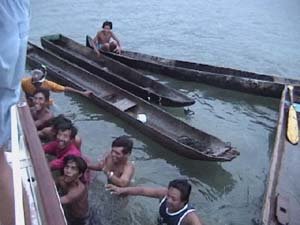 |
|
 Click
on this image for a video of the celebration when Andanté
slides off the mud bar. Click
on this image for a video of the celebration when Andanté
slides off the mud bar.
Warning:
Your media player will open and download a 19 MB video file. This
will require a degree of patience, even with a cable modem connection.
|
| |
Kuna
Reinforcements to the Rescue
|
|
|
All eight
Kuna guys screamed in victory with their hands high in the air. We rewarded
them with the universal sign of gratitude: eight ice cold Coca Colas.
(I'd like to teach, the world to sing, ya da, DA DA, DA DA, OK, I'll stop.)
It would
have been great to get all of this on video, and Becky did. (Click on
image at right. Read download warning first!)
Next we had
to remove the water from our diesel tank and engine. The hand pump for
the diesel tank that hung in readiness inside the engine room door had
rusted shut. I couldn't even budge the handle. Instead, I used an ample
supply of the universal problem-solving—duct tape—and attached
my ThirstyMate handheld bilge pump to the fuel tank line. I pumped about
an hour, and removed six gallons of water from the tank.
Becky and
I collapsed for the evening, discouraged, but hopeful that we could get
the engine running the next day. We turned off every nonessential electrical
device on the boat to conserve energy, and even washed and dried dishes
by candlelight.
6:30 the
next morning I attached a spare electric bilge pump to the fuel tank line,
and switched it on. Three hours later, we finally found the diesel fuel
in the tank. Including the previous evening, we pumped approximately
40-gallons of water out of the tank. I purchased a 55-gallon drum,
and 40 gallons of it was water—73%. At $2.00 per gallon. Great margins.
Now came
the hard part: purging water from the engine system. Next I connected
the pump to the fuel line that fed the engine, and pumped it free of water.
Referring to my Volvo shop manual, I opened the bleed nut on top of the
secondary fuel filter, and pumped water out from the fuel pump to the
fuel filter. Only this time I had to use the manual fuel pump on the engine—a
small button on a metal stem designed for the sole purpose of making your
thumb sore. I pumped: "wicka wicka wicka wicka wicka wicka."
Two
minutes later diesel came out of the bleed valve. I removed the secondary
fuel filter, and replaced it with a new one.
Our friendly,
helpful, energetic boating neighbor Gregoire arrived, and over the next
several hours the two of us cleaned the primary fuel filter, put in a
new filter cartridge, cracked open and bled each fuel injector, started
the engine, and … nothing. After that, we started all over again,
bleeding each part of the engine system, step-by-step, until we turned
the key and … nothing.
At this point
it was early afternoon, and the engine wasn't about to catch. To make
matters worse, our batteries were approaching 50% drain. Gregoire returned
to his wife and family while I used precious amounts of draining battery
power to call the Volvo dealer in Seattle for advice. The advice was:
the fuel injectors were probably scored by the water, and the fuel pump
was most likely damaged as well. "You'll probably have to pull all
four fuel injectors and test them," the service manager informed
me." Are you aware of any Volvo dealers in Central America?"
I asked. "No," came the reply.
I informed
Becky about the bad news, and I started adding up the potential costs
of the batteries draining to zero in about 36-hours: $300 worth of food
in the refrigerator and freezer that would go bad. The new membrane that
we installed for the water maker would go bad. Five D-gell batteries,
probably toast. Cost of flying mechanic into Rio Diablo from God knows
where. Or we would have to sail without an engine all the way back to
Colón—about 150 miles—through the San Blas reefs.
Right then
and there I thought about making a deal on the boat to a local Kuna bidder.
Maybe we could trade it for a dugout canoe with a scrap of sail, four
buckets of molas, and we could continue our adventure. Yeah, it's a little
breezy, but you wouldn't have to worry about the engine or the water maker.
An hour later,
Gregoire returned, as did Federico—with a retired diesel mechanic
in tow. Paco, the diesel mechanic, was a Panamanian who had married a
Kuna woman, and now lived in Rio Diablo. Paco had a vested interest in
our solution, since he sold us the water-infested diesel (diesel-infested
water?) to begin with. He said that three out of five barrels that he
recently purchased contained mostly water. No kidding.
Gregoire
and I explained the situation to him: how much water we had removed, how
we had changed the filters, primed the lines, bled the injectors, etc.
etc. Paco listened intently, and then spread his hands in the air and
shook his head, like a modern day Moses, as if to say, "stand back
boys."
Paco knew
the exact sequence to bleed the fuel injector valves: One and four. Then
one and three. Then two and four. He proceeded methodically. Patiently.
Two hours later, after many many attempts to get the engine started, it
finally jumped to life. Scored injectors be damned—the engine never
sounded so good to me. We drained an additional two gallons of water mixed
with diesel from the inside of the engine. Becky and I hugged each other,
and smiled as diesel fumes filled the boat.
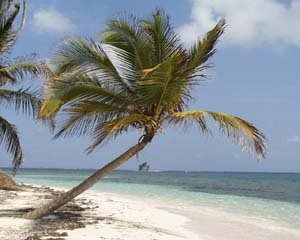 |
|
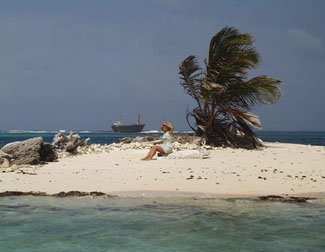 |
|
|
Coco
Bandero Cays, The San Blas Islands
|
|
Shipwrecked
|
|
With the
water completely purged from our tank and engine, we hopped over to Coco
Bandero Cay—four unbelievably beautiful tropical islands that we
had all to ourselves for about six days of island exploring, snorkeling,
and lounging.
After that
we sailed over to Eastern Holandes Cay where we snorkeled around a small
reef inside the lagoon, with the larger ocean-edge reefs surrounding us
on all the islands. By now you may have read Becky's first shark story
in this log's Becky's BYTES. Here's the second shark story:
We snorkeled
around a shallow little coral mound in the lagoon, perhaps measuring 150-feet
by 150-feet. We swam along in about 20-feet of water when a 10-12 foot
long shark passed about 15-feet away from us. You've heard many people
say this, but now it's my turn: I've never been so frightened in my life.
This thing was twice as long as I am. It was HUGE.
As it swam
past us I grabbed Becky's hand and pulled her back to the dinghy, leaving
a wake on the surface. I have never been so close to something that big
in my entire life—it was almost four feet wide. We spoke to
some local Kunas who said that someone had been bitten in the area several
years ago. That encounter cured us of wanting to go into the water in
the San Blas for a while.
| |
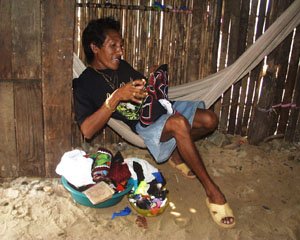 |
| |
Venancio
Restrepo
The Master Mola Maker at Work
|
Instead of
more snorkeling, we sailed southeast to Mormaketupu Island where Venancio
Restrepo lives. You may recall from the previous log that Venancio is
the master mola maker of San Blas. His elaborate and colorful designs
command up to $50 a mola.
The tiny
island of Mormaketupu measures only several hundred feet in diameter.
But it's home to over 100 Kuna people, including Venancio, his three sisters
and three brothers—their spouses and children, mother, and father—who
all live together. Mormaketupu has no running water. Like Nargana, villagers
must paddle or sail their dugout canoes up a river where they collect
water for drinking and bathing. The trip to the river yields enough water
for only two days. No generators supply electricity. When the sun sets,
the village turns dark. Homes are constructed of thin wood poles and roofs
thatched from palm fronds that cover packed dirt floors. Few huts have
mattresses. Hammocks are strung high above the floor. Living huts cover
every square inch of the island, except for the dirt paths between them.
Even after
visiting the village and seeing all of this firsthand, it's difficult
to imagine what that kind of life would be like: no water, no electricity,
no conveniences. And no opportunity: Education stops at about age 13.
We invited
Venancio, a brother, and one of his sisters and her girlfriend, to visit
us on Andanté. When they arrived around 16:00 one afternoon, with
two children in tow, we gave them a tour of the boat. We showed them our
web site and the destinations where we had traveled over the past two
years. As we snacked on microwave popcorn in the cockpit, we also showed
them a National Geographic article on CD, written about the Kuna people
in 1941.
Sixty years
later, the kuna people appear virtually the same as the 1941 photographs.
The only noticeable difference: in 1941 women wore large rings through
their noses, which were pierced when the girls were still infants. Today,
only a small nugget of gold is visible inside the end of each woman's
nostril. Girls wear contemporary clothing until about age 15. Then, to
signify their womanhood, they get their noses pierced, their long black
hair cut short, and they begin wearing the traditional, colorful Kuna
dresses.
The End
... for now
In May of
2001, after writing this log, we toured Guatemala for two weeks, and then
returned to the US. After returning home we decided to stop cruising for
a while. But we hope to be able to continue these logs with new sailing
adventures in the future. If you want to contact us, you can still reach
us at: andante@karlbuhl.com
|

